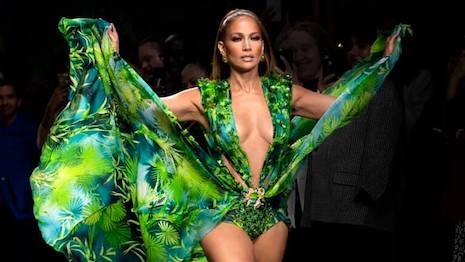 Dior's spring/summer 2020 show. Image credit: Dior
Dior's spring/summer 2020 show. Image credit: Dior
Influencers, celebrities and owned media channels are powerful promotional tools during fashion weeks, with these placements generating a greater portion of impact value for brands than their share of voice. According to data from Launchmetrics, media coverage represented about seven-tenths of the total placements for brands during the major fashion months, and around half of the total media impact value was generated by the press and blogs. Among the drivers of media value during runway shows last year were stunts and sustainability, as brands attracted press through environmental efforts and large-scale catwalk moments. "Last season was unique in the sense there were several newsworthy moments that generated the interest of the greater public," said Alison Bringé, chief marketing officer at Launchmetrics, London. "Influencers and celebrities are great opinion leaders when it comes to creating awareness, yet it only reaches as far as their sphere of influence, whereas the media can connect with a greater audience and translate what happens on the runways to the regions and audience in question. "Between the Jennifer Lopez appearance to the steps taken in the realm of sustainability on behalf of global brands such as Dior or Gucci, the media certainly had more than enough to speak to and didn't hesitate to cover the stories in the consumer press," she said. Media mentions Across the fashion weeks in New York, Paris, London and Milan, New York had the most media impact value last year. The spring season overall had more buzz surrounding it, but London balked the trend with a stronger media presence for the fall runways. Influencers accounted for 90 percent of the top social media posts during the fall fashion weeks, while celebrities and influencers were 100 percent of the most impactful social posts from the spring runways. Versace was the top brand across all four major fashion weeks during the spring/summer 2020 season, generating about $22 million in media impact value. The brand’s Milan show featured Jennifer Lopez modeling a new version of the gown she wore to the 2000 Grammy Awards.
 Jennifer Lopez walked during the finale of Versace's show. Image credit: Versace
Jennifer Lopez walked during the finale of Versace's show. Image credit: Versace
 Tommy Hilfiger's show. Image credit: Tommy Hilfiger
With luxury brands having an increasingly global presence, the media impact of fashion weeks in the U.S. and Europe extended beyond these regions to areas including Brazil and China. This international approach is also affecting how brands are staging their shows, with many opting to take their collections on holiday to a destination outside of their hometowns.
"In order to create viral moments at their shows, brands should think beyond the runway and industry confines," Ms. Bringé said. "If you look at the Versace spring/summer '20 show, the success was due to the fact that they were able to resonate beyond the fashion world and speak on greater, global trends.
"They connected with the average consumer through early '00s nostalgia and by linking the story to the creation of Google Images, which is something that we can all relate to," she said. "To that note, brands should consider building moments that are true to their values but also true to the current societal undertones."
Value of values
Transparency around a brand’s corporate values is of increasing importance to consumers, particularly millennials and Generation Xers.
Tommy Hilfiger's show. Image credit: Tommy Hilfiger
With luxury brands having an increasingly global presence, the media impact of fashion weeks in the U.S. and Europe extended beyond these regions to areas including Brazil and China. This international approach is also affecting how brands are staging their shows, with many opting to take their collections on holiday to a destination outside of their hometowns.
"In order to create viral moments at their shows, brands should think beyond the runway and industry confines," Ms. Bringé said. "If you look at the Versace spring/summer '20 show, the success was due to the fact that they were able to resonate beyond the fashion world and speak on greater, global trends.
"They connected with the average consumer through early '00s nostalgia and by linking the story to the creation of Google Images, which is something that we can all relate to," she said. "To that note, brands should consider building moments that are true to their values but also true to the current societal undertones."
Value of values
Transparency around a brand’s corporate values is of increasing importance to consumers, particularly millennials and Generation Xers.
